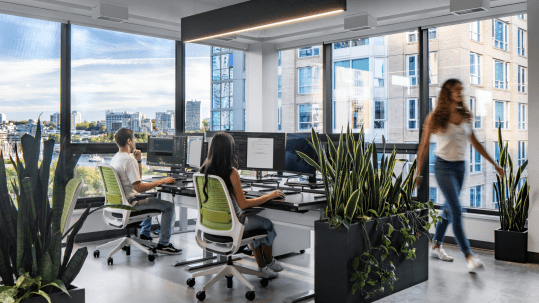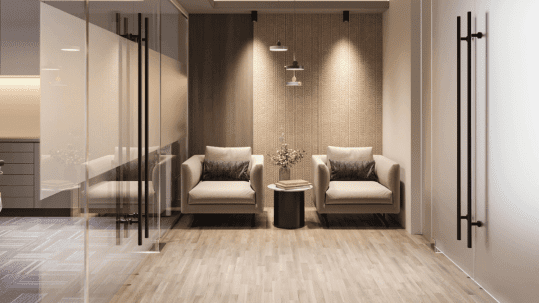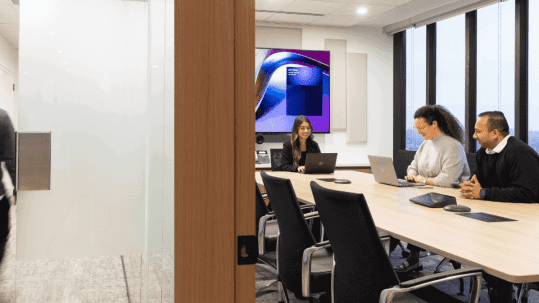Remember the Three R’s from public school? They’ve never been more relevant as eco-friendly initiatives, recycling, reusing materials, and renewable energy are handily at the forefront of today’s societal consciousness.
Making your office more sustainable has a plethora of benefits – from helping ease the pressure of elevated utility fees and growing capital expenditures, to generating positive client and public perception and a company culture that’s dedicated to ethical, eco-friendly choices that make the office a more pleasant place to be.
In today’s rapidly shifting office design landscape, office sustainability is as important as ergonomics and technology. In this post, we’re examining some of the most powerful ways to make your office more sustainable.
Power
Businesses thrive on power. Electricity, internet access, water, hydro, gas, etc are all critically important to organizational success, employee comfort, and economic viability — your business can’t operate without power, but is it operating on the power it needs? Or operating by consuming excess power, in turn inflating bills and disproportionately using the grid?
Phantom power or standby power is a quiet, yet widespread issue among many offices. When a workstation is powered off but still plugged in, that station is still drawing power and effectively wasting it. Ensuring employees feel empowered to unplug their workstations at the end of the day will dramatically reduce the draw of power, not only helping reduce overhead utility fees within the office but conserving power elsewhere.
Motion-activated lighting can help to reduce or eliminate excess electricity use in your office by installing new motion-detectors on lighting or installing timers to ensure lights are shut off at a certain time of the day to take advantage of reduced utility rates. Eco-friendly LED bulbs can further your energy-saving efforts in terms of power consumption and can aid in the increase of natural light for employees when daylight bulbs are swapped in, helping kill two birds with one stone.
Waste
Waste generation is a big issue on most employee and management’s minds during an effort to ramp up sustainability efforts in the office. Begin by seeking to eliminate waste through an office sustainability plan. Rather than placing trash bins net to every employee desk, place one large bin in a centrally located space, and accompany it with various recycling bins to help persuade your staff to recycle, rather than seek the ease of the trash bin.
Make the bold move to go paperless by moving away from printed company memos, reports, analytics, and reminders – opt instead for a digital company network using cloud-based technology to share posts, ideas, and reminders interally without the use of wasteful junk mail and one-time-use paper products.
Water consumption is another ethical dilemma for environmental sustainability discussions, and using less is a fantastic way to reduce the impact your office has on the planet, and saves money. Conserving water is easy when your office implements timed push, or touch taps in restrooms, as well as flow-sensitive fittings that reduce the amount of water that flows from faucets, and the duration of time from which it may flow. Water-efficient urinals and toilets may be applicable in many cases as well and help to drastically reduce water consumption in the office.
Sustainability as Company Culture
Using an eco-friendly ethos to usher in a strong company culture based around sustainability is a great way to not only do your part in reducing emissions, waste, and consumption of energy, but it’s a perfect way to create a lighthearted energy in the office that creates an environment of collaboration, idea-sharing, and support.
Creating monthly green challenges and a green office program is key to challenging your staff to flex their muscles and contribute to a company culture determined to minimize their use of energy and wasteful products, and maximize their dedication to maintaining an environmentally friendly workspace.
Luckily, encouraging your staff to act on these ethical principles of sustainability isn’t that tough; a recent survey from Net Impact shows a workspace that proudly displays a moral, ethical stance on sustainable development is key to employee satisfaction. Over 80% of young employees agreed they’d prefer to work for a company that cares about its impacts, while over 50% said they’d flat out refuse to work for a company that they felt was environmentally irresponsible.
Design
When renovating, or considering a fresh new office build, consider using design elements from the demolition process as focal points to introduce unique and innovative aesthetics to your build For example, rather than throwing away old timber rafters, use them as classy exposed supports elsewhere in the build, or fashion them into benches or seating in the staff cafe or break room as a recycled element that showcases the history of your renovation.
When designing a new build, position your most populated office spaces in the south-facing sector of the office to ensure ample natural light has a chance to pour through, both psychologically benefitting the employees in terms of exposure to natural light, and helping to lower the likelihood you’ll need to crank the thermostat in the colder months south-facing windows will help to naturally warm the space using the sun, and can help lower emissions.
When replacing old furniture in favor of new office chairs and desks, donate your outgoing assets to a firm that could use your stuff. If you don’t have a close affiliate that could use them, make a post on social media declaring you’re giving away free office furniture first-come-first-serve. This recycles the furniture and ensures it sees new life elsewhere, rather than winding up in a landfill. As the old saying goes, one man’s trash it another man’s treasure and your outgoing design may be the perfect compliment to another office space nearby.
Sourcing high-quality materials is a great way to introduce sustainability and more ethical behavior into commercial office design — begin your office renovation by investigating eco-friendly products, ethically-sourced lumber, eco-friendly cleaning products, and natural materials that may be recyclable or biodegradable as key pillars to your expansion or revamp plans.
—-
Being eco-friendly is about more than fair trade coffee and organic cotton clothing – it’s about consciously consuming less power, fewer resources, and sourcing sustainable and ethical products over cheap and wasteful alternatives.
Making your office more sustainable isn’t just a trendy and advantageous thing to do in 2019, it helps to address the biggest ethical issue of our time — using more than we need isn’t just wasteful and unethical – it’s also bad for business in the long run.
Going green has never been so beneficial.






